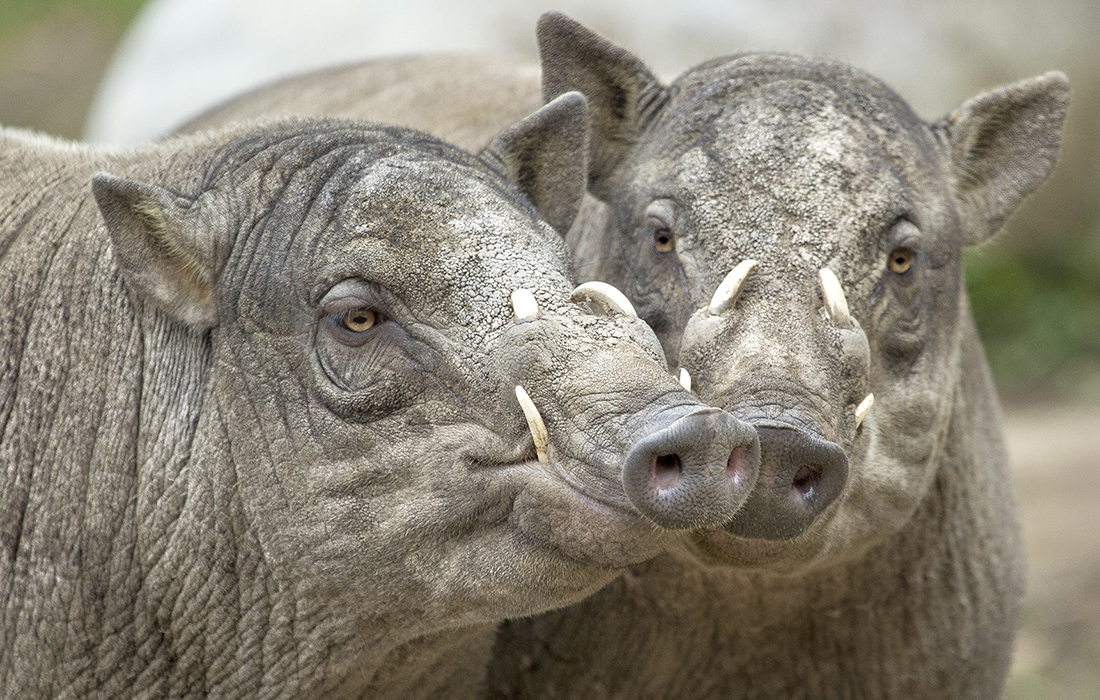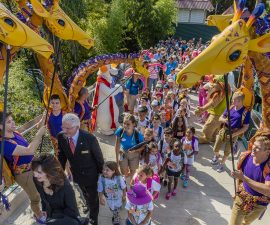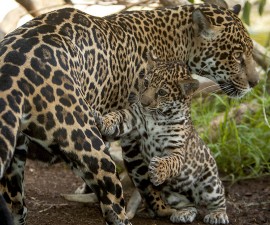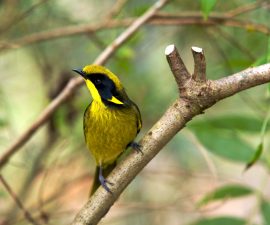BY Peggy Scott
Photography by Ken Bohn
There are certain characteristics that help define swine. Members of the Suidae family are, for example, medium-size, intelligent omnivores with bristly hair, short legs, a compact body, and a long, pointed head that is highlighted with tusks. These even-toed ungulates (Order Artiodactyla) use their snouts to root out tasty treats such as grubs and tender new vegetation. They build nests and give birth to litters of striped offspring. So all suids are exactly alike, right? In a pig’s eye! One look at the babirusa, a genus of wild swine found in areas of Indonesia, reveals that this animal is the poster child—or piglet—for uniqueness.
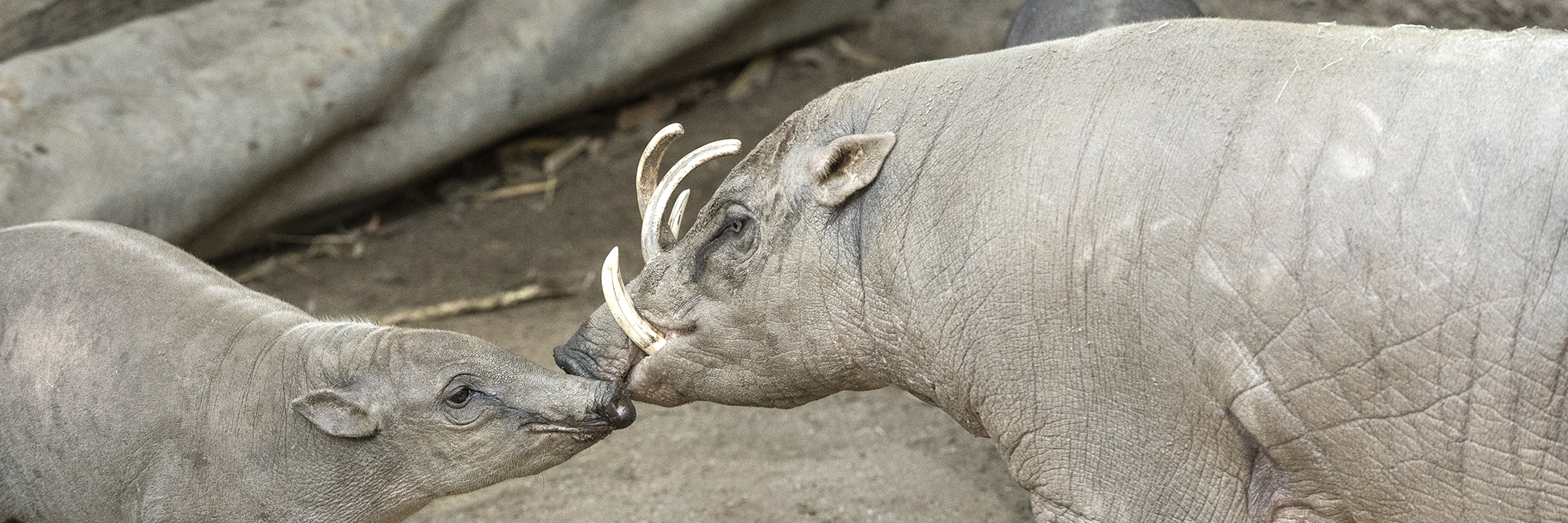
 Pair of teats on a female babirusa
Pair of teats on a female babirusa
Portrait of a “Pig-deer”
Translated from the Malay language, the word babirusa means “pig-deer,” and a glance at the mouth (and head) gear on an adult male Sulawesi babirusa Babyrousa celebensis, like the one residing at the San Diego Zoo, reveals why. The babirusa’s lower tusks, while formidable, are overshadowed—literally and figuratively—by its startling upper tusks (canine teeth) that grow right up through the skin in their snout and curve back toward their forehead, reminiscent of deer antlers. While both genders have lower tusks, only males possess the elaborate upper tusks, which can reach 12 inches in length. The Sulawesi babirusa’s relatives, the Moluccan (or hairy) babirusa Babyrousa babyrussa and the Togian babirusa Babyrousa togeanenis, sport similar dental adornments, making the family resemblance unmistakable. Like many pigs, the male babirusa’s canine teeth continue to grow throughout its life, as long as there is a blood supply—like our fingernails and our hair.
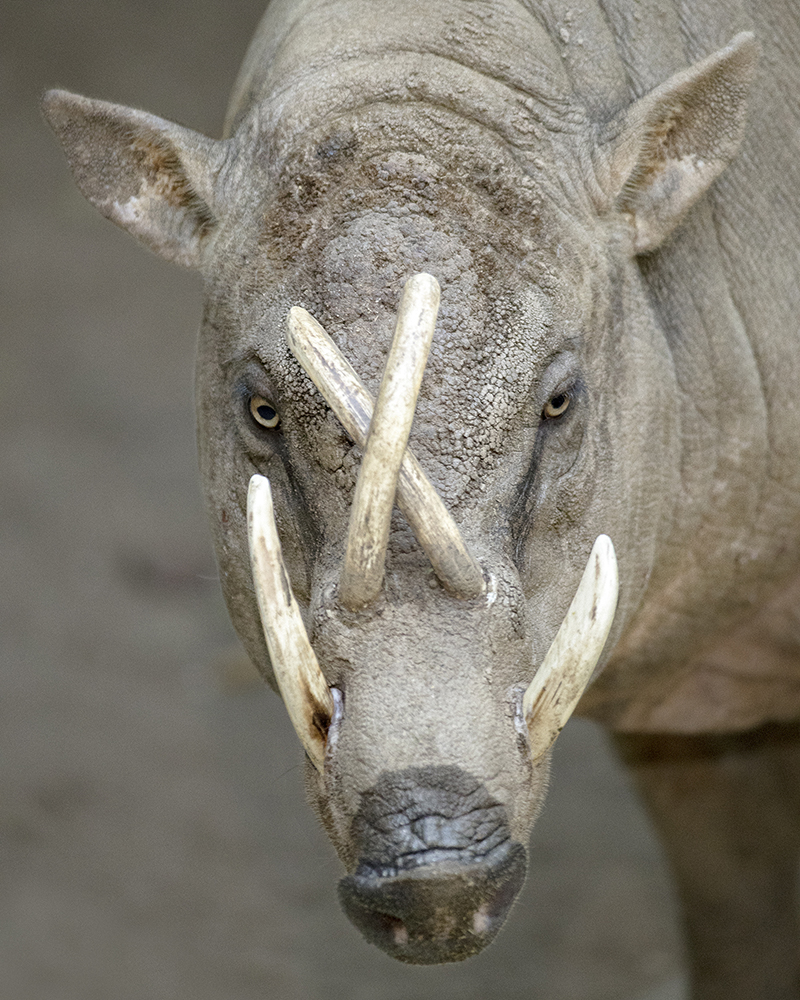
OVER (OR THROUGH) THE TOP
A male babirusa’s upper tusks grow through the top of its snout and may help protect its face during fights.
As eye-catching as those tusks are, however, their utility is subject to some debate. The tusks’ backward curve makes them less-than-ideal weapons, notes Lisa Martin, an animal care manager in the Collections Husbandry Science department at the San Diego Zoo, adding that it may be more a matter of appearance. “The tusks may attract females, and they look fierce, so they could be used in a ‘display’ rather than for actual fighting,” Lisa says. “And the way they curve up, they could help protect the babirusa’s eyes if the animal did get in a fight.” Should a scuffle break out, the tusks’ usefulness could be short-lived. Unlike elephant tusks, babirusa tusks are brittle and breakable. That may be one reason that a babirusa fight looks much different than one of other tusked animals: the animals rise up on their hind legs and “box” each other with their front hooves.
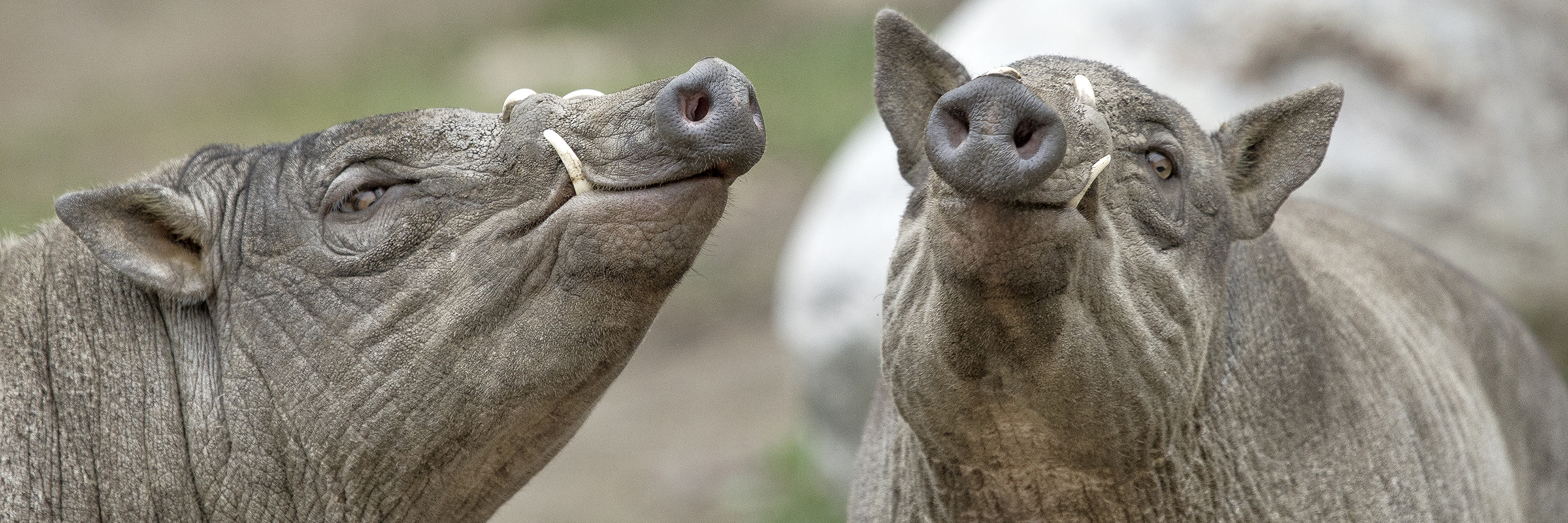
 The length, in inches, of a babirusa’s tail
The length, in inches, of a babirusa’s tail
A Pig of a Different Color—and Character
Babirusas’ barrel-shaped bodies, height (two feet at the shoulder), and deer-like legs help them easily traverse their rain forest habitat. They are brownish-gray in color, with only the sparsest of hair scattered over their bodies. Males can weigh 200 pounds or more. More solitary than other pigs, babirusas even keep their families smaller, usually producing litters of only one or two piglets, which lack the stripes that adorn many other wild pig babies. But what they lack in pattern they more than make up for in pluckiness—babirusa piglets typically wander from the nest and sample solid foods before two weeks of age!
Like other pigs, babirusas make good use of their snout, if a little differently. Instead of using it only to search for food, babirusas scent mark by “plowing,” which involves thrusting their snouts deep into the soil, kneeling down, and pushing themselves forward, digging a groove in the mud. They simultaneously produce excessive saliva, which contains pheromones. Plowing is primarily an adult male habit, although subadults of both sexes have been reported doing it.
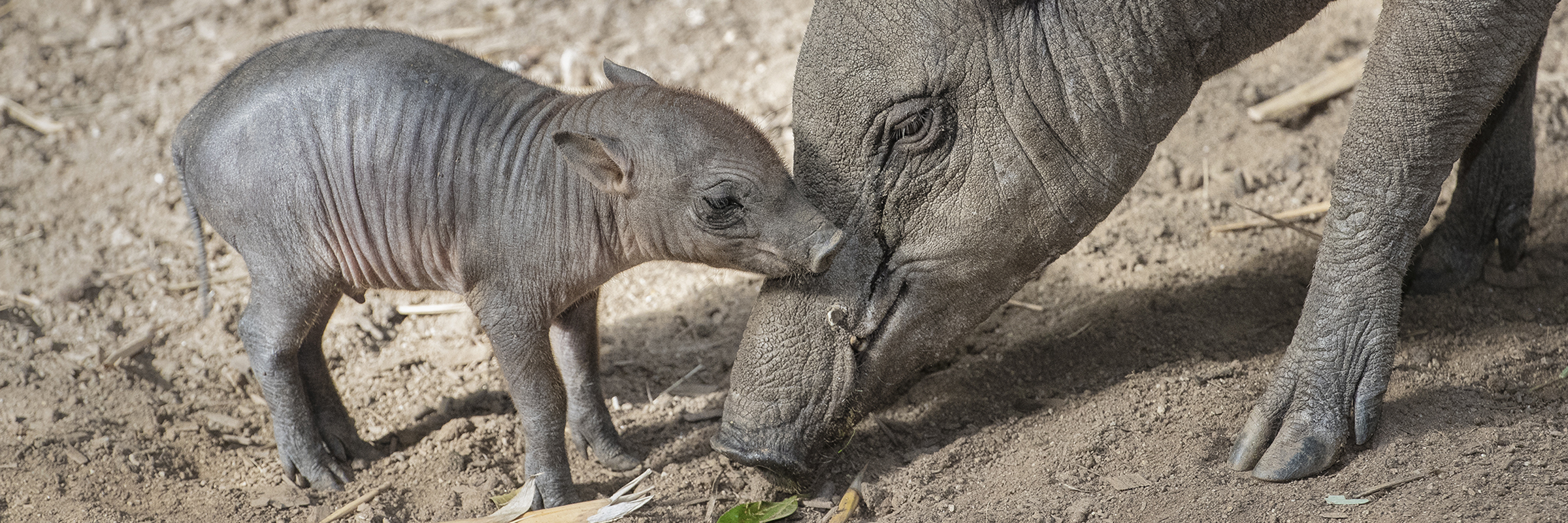
 The possible life span for babirusas in zoos
The possible life span for babirusas in zoos
This Little Piggy…
The San Diego Zoo’s babirusa crew began making waves (and headlines) in September 2016, when Fig gave birth to the Zoo’s first-ever babirusa piglets. Dubbed her “figlets,” the adorable female babies became media darlings, and the pair—Sula and Wesi—are still visitor favorites, along with Mom, in their exhibit at the top of Tiger Trail. Senior keeper Victoria Girdler was immediately taken with the unusual species when she began working with them about a year and a half ago. “They are so curious, especially the piglets, and always want to see what we’re doing,” Victoria says. “They follow us, want to look in the wheelbarrow; they don’t miss a thing.”
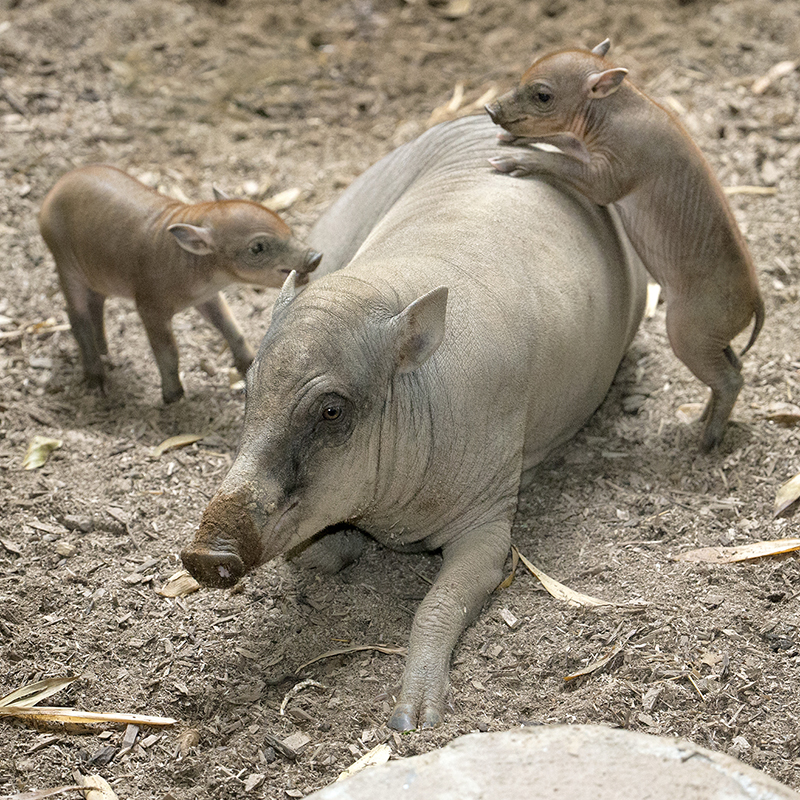
“WE’RE NUMBER ONE (AND TWO)!”
Fig gave birth to the Zoo’s first-ever Babirusa piglets last year.
Another eager little face joined the group last March, when Mary-Kate gave birth to a single male piglet. At first, Mary-Kate and her baby were kept in a separate enclosure from the rest of the babirusas, and Mary-Kate made the most of it. “She stacked her bedding up super thick, using three hay beds to make one giant ‘Princess and the Pea’ bed,” Victoria says. “She uses that snout and completely covers herself up. She’s so cute.” Her youngster seemed to take after his half-sisters (they all have the same father) in the personality department. “He likes to hide under our wheelbarrow to surprise his mom,” Victoria says, adding that she was surprised at how quickly the baby grew. “He tripled in size in his first three weeks!”
Victoria notes that she was impressed with the maternal skills of both babirusas, given their lack of experience. “Both Fig and Mary-Kate were first-time moms, and they were such good mothers!” She adds that the babirusas are quick learners and amiable students. “Fig is working on husbandry training for hoof work and other procedures and is doing really well. She enjoys a good belly rub, too.”
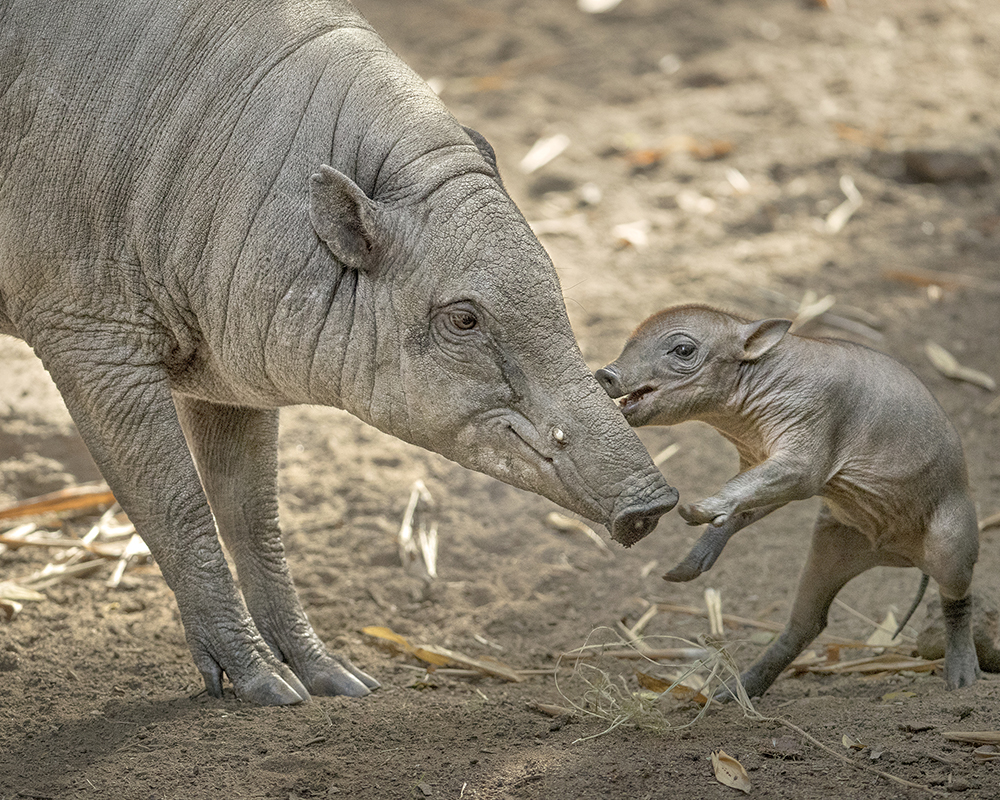
A BOUNCING BABY BOY
Mary-Kate’s piglet is a spirited little swine.
Seven-year-old Jethro is the father of all three babies, and is a good-natured—if big—boy himself. “He likes a good scratch through the fence,” Victoria says, noting that keepers work with Jethro using protected contact.
While Mary-Kate and her new arrival enjoyed a little bonding time, the rest of the group got along just fine, enjoying mud wallows and group snuggles. Given their intelligence, keeping pigs busy and engaged is key to their well-being. “They love new smells, so recently we rubbed fresh rosemary on their enrichment toys,” Victoria explains. “And their spinner feeders dispense grain, so they can root around.”
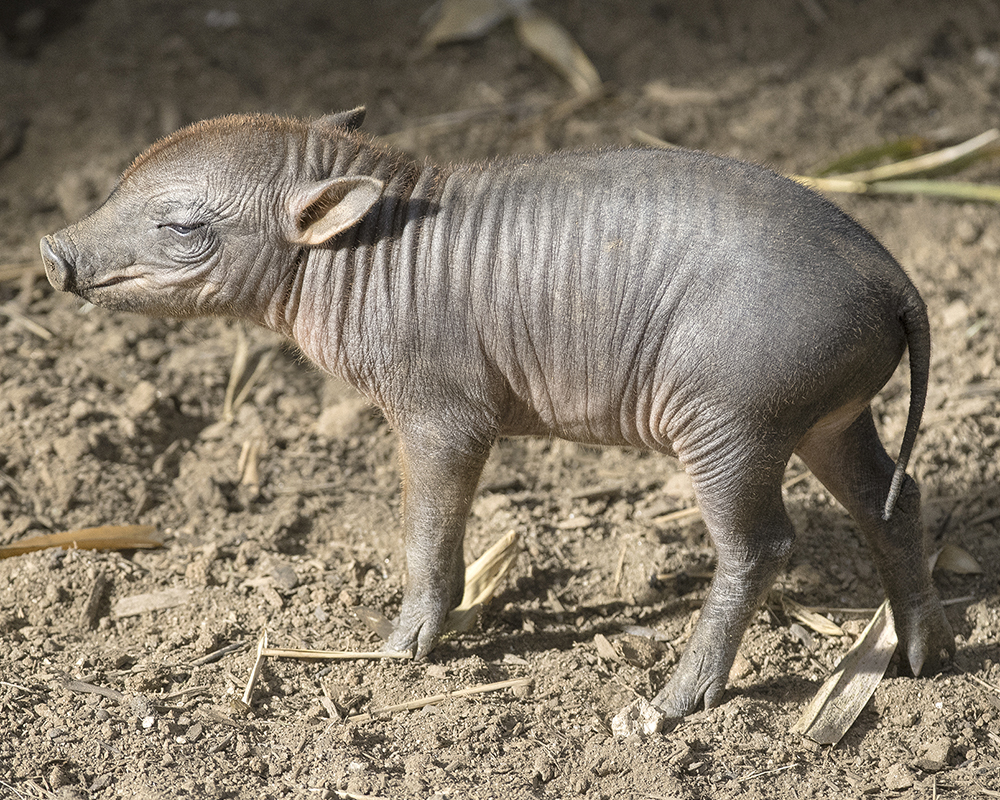
GROWING BY LEAPS AND BOUNDS
Mary Kate’s rambunctious youngster is also healthy, growing boy—he tripled in size in his first three weeks.
Along with grain, the babirusas, as grazers, enjoy alfalfa hay and a special herbivore pellet, along with plenty of spinach, bok choy, red cabbage, and root veggies. And what counts as “dessert” or treats? “Apples and bananas are great for training,” Victoria says.
Getting to know the babirusas was quite an experience for Victoria. “I love how silly and curious they are in general,” she says. “They are great ambassadors for their species.” And their species can use the help. Their wild population was thought to be stable, but a long history of hunting, habitat loss, and logging has caused their population to decline by more than 30 percent in the last 18 years. With conservation efforts, and additions such as our most recent three little pigs, perhaps the babirusa story will have a happy ending after all. “They are such unusual animals,” Victoria says. “And they’re all so special in their own way.”

